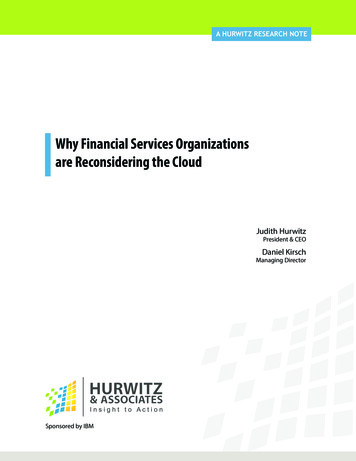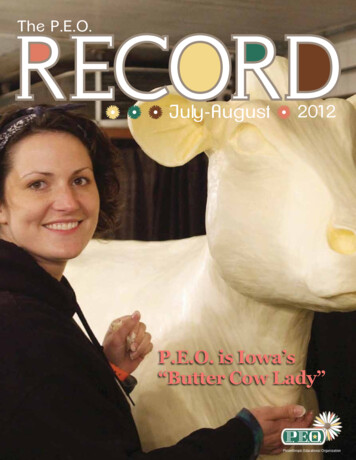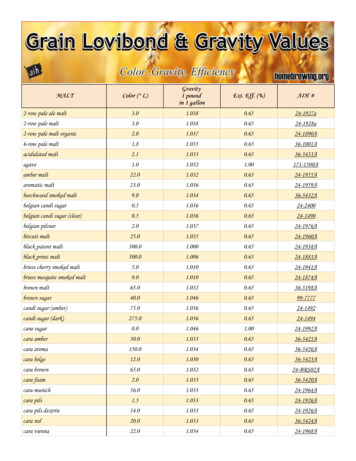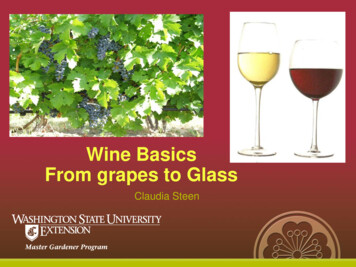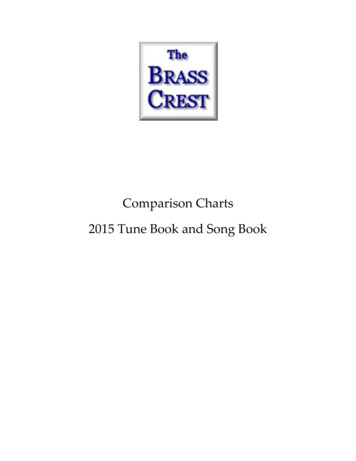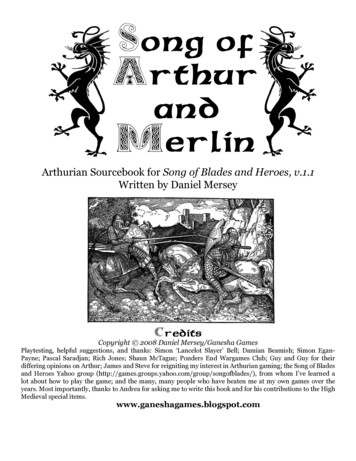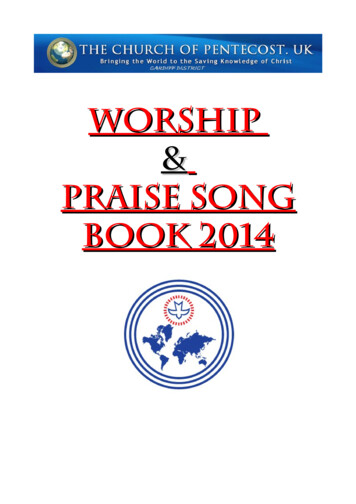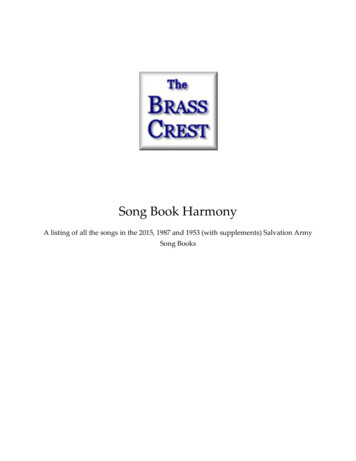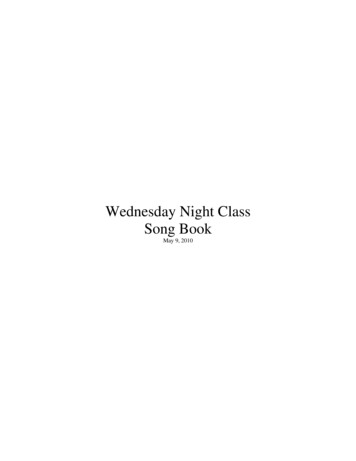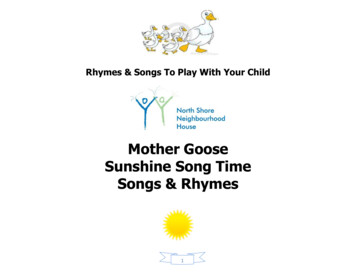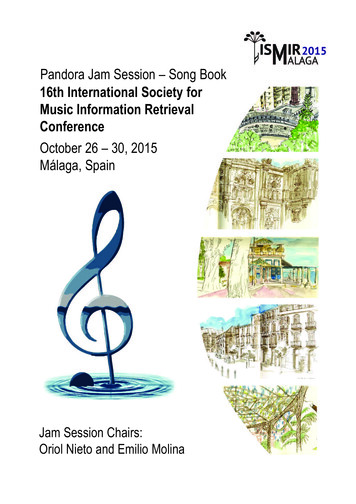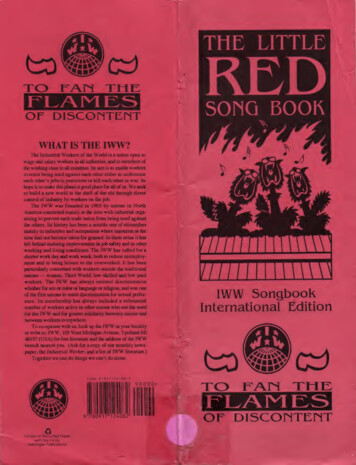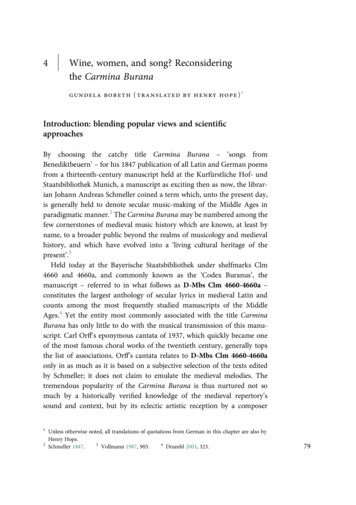
Transcription
4 Wine, women, and song? Reconsideringthe Carmina Buranagundela bobeth (translated by henry hope) 1Introduction: blending popular views and scientificapproachesBy choosing the catchy title Carmina Burana – ‘songs fromBenediktbeuern’ – for his 1847 publication of all Latin and German poemsfrom a thirteenth-century manuscript held at the Kurfürstliche Hof- undStaatsbibliothek Munich, a manuscript as exciting then as now, the librarian Johann Andreas Schmeller coined a term which, unto the present day,is generally held to denote secular music-making of the Middle Ages inparadigmatic manner.2 The Carmina Burana may be numbered among thefew cornerstones of medieval music history which are known, at least byname, to a broader public beyond the realms of musicology and medievalhistory, and which have evolved into a ‘living cultural heritage of thepresent’.3Held today at the Bayerische Staatsbibliothek under shelfmarks Clm4660 and 4660a, and commonly known as the ‘Codex Buranus’, themanuscript – referred to in what follows as D-Mbs Clm 4660-4660a –constitutes the largest anthology of secular lyrics in medieval Latin andcounts among the most frequently studied manuscripts of the MiddleAges.4 Yet the entity most commonly associated with the title CarminaBurana has only little to do with the musical transmission of this manuscript. Carl Orff’s eponymous cantata of 1937, which quickly became oneof the most famous choral works of the twentieth century, generally topsthe list of associations. Orff’s cantata relates to D-Mbs Clm 4660-4660aonly in as much as it is based on a subjective selection of the texts editedby Schmeller; it does not claim to emulate the medieval melodies. Thetremendous popularity of the Carmina Burana is thus nurtured not somuch by a historically verified knowledge of the medieval repertory’ssound and context, but by its eclectic artistic reception by a composer12Unless otherwise noted, all translations of quotations from German in this chapter are also byHenry Hope.34Schmeller 1847.Vollmann 1987, 905.Drumbl 2003, 323.79
80Gundela Bobeth, translated by Henry Hopewho is likely to have been unaware of the musical notation of D-Mbs Clm4660-4660a.5 Drawing on an obsolete image of the Middle Ages, in whichitinerant scholars with unbounded sensuousness indulged excessively inwine, women, and song, Orff’s setting – like its spectacular production andfilm adaptation by Jean Ponnelle in 1975 – offers a paradigmatic exampleof the modern usurpation of songs from D-Mbs Clm 4660-4660a as areflective space for romantic visions of the Middle Ages.6From the beginning, the popular imagination and academic study ofD-Mbs Clm 4660-4660a’s songs shared a fascination for this repertoryof unique scope, content, and design, which as an ‘inestimable monumentof the Latin Middle Ages and its love of poetry and song’ promisedfar-reaching insights into the non-liturgical musical life of the High MiddleAges.7 The remarkable combination of poems of a moralizing–satiricalnature, criticism of the Church and Curia, blatant lovemaking, exuberantcarousing, and pleasurable idleness soon after the manuscript’s discoveryearned D-Mbs Clm 4660-4660a a reputation as ‘the most famous andimportant collection of “vagrant poetry”’.8 In the context of a historicallyand philologically determined understanding of the Middle Ages in thenineteenth century, these features established the manuscript as infamous,especially since Schmeller’s well-intended decision to suppress inappropriate passages from the texts and collate them on the final page of hisedition helped to overemphasize the manuscript’s frivolities.9 The owners,makers and performers of such explicit poetry, it was then believed, musthave been socially marginalized groups – an itinerant class of scholarsand eternal students opposed to the Church, whose promiscuous lifestyle5679Since Orff is known to have worked exclusively with Schmeller’s commentary-free edition – theonly complete edition available in his day – he is unlikely to have been aware that neumaticnotation existed for some of the texts he set to music; these were, in any case, irrelevant to hisplans. More generally, Orff seems to have had only a vague idea of early thirteenth-centurymusic, as a letter which he sent to his philological advisor Michel Hofmann during his work onCarmina Burana demonstrates: ‘I want the text to be used in the truly ancient way. Double texts,including a mixture of Latin and German’ (Frohmut Dangel-Hofmann, 1990, 19, originalemphasis); Orff appears to be alluding to the later compositional practices of motets.See Carl Orff, Carmina Burana: Cantiones profanæ cantoribus et choris cantandæ comitantibusinstrumentis atque imaginibus magicis. Dir. Jean-Pierre Ponnelle. With Lucia Popp, HermannPrey et al., Chor des Bayerischen Rundfunks, Tölzer Knabenchor, MünchnerRundfunkorchester, with Kurt Eichhorn (leader). Gerhard Reutter (producer). ZweitesDeutsches Fernsehen, Bavaria Film- und Fernsehgesellschaft, 1975. DVD release: RCA RedSeal, 2002.8Bischoff 1970, 31.Hilka and Schumann 1930–70, II.1, 82*.Schmeller justified his censorship of a total of five songs with the notion of propriety, andrecommended that his more sensitive readers cut out the final page of his edition, whichcontained the omitted passages in small print. See Düchting 2000.
Reconsidering the Carmina Buranaof addictive gambling and drinking seemed to find vivid expression in theconfession of the Archpoet contained in the D-Mbs Clm 4660-4660a(Estuans interius ira vehementi (CB191)). The precipitous adoption ofsuch texts for the alleged realities of their poets – and, occasionally, alsofor those of the scribes of D-Mbs Clm 4660-4660a, which thus evenbecame a ‘vagrant’s song book’ – are the roots of the excessively Bohemianimage of the Carmina Burana that cemented itself through the inclusionof its Latin drinking songs in student songbooks and other anthologiesto be used for communal singing as early as the nineteenth century,10 andwhich continues to exert its influence through Orff’s adaptation.The foundation for the academic scrutiny of the collection was laid inthe 1930s by Otto Schumann with his comprehensive and critical completeedition of the Carmina Burana (encouraged by Alfons Hilka, and basedon preliminary work by Wilhelm Meyer).11 In contrast to the prevailingideas of the Carmina Burana, Schumann critiqued the notion that thepoets and users had been ‘people [. . .] for whom drinking, gambling, andidleness was a way of life’.12 Since then, the parameters for an objectivescrutiny of the Carmina Burana have changed significantly. Following thecritique of the rigid polarization between ‘sacred’ and ‘secular’ prevalentin nineteenth- and early-twentieth-century historiography, it is no longerinconceivable to image the creation and performance of Latin poetryof bold content within the context of a monastery, an episcopal court,or a cathedral school.13 The concept of ‘vagrant poetry’ outside of anyinstitutional context has also been brought into question: many of thealleged itinerants – among these, in all likelihood, even the Archpoet – arenow known to have had at least temporary roles in reputable offices; andrevision to the medieval concept of vagantes has shifted its focus from anotion of easy-going vagabonds to spotlight homeless or travelling clerics,10111213Hilka and Schumann 1930–70, II.1:72*. See also Hüschen 1985, 46–53.W. Meyer 1901 managed to connect seven bi-folios to the manuscript’s original corpus (D-MbsClm 4660a), and was crucial to the reconstruction of the original ordering of the leaves andgatherings (which had been obscured by Schmeller’s numerous additional errors). The first twovolumes of Schumann’s edition, I.1 and II.1 were published in 1930; the second text volume(II.2) followed in 1941. The seminal text edition was concluded with volume I.3 only thirtyyears later by Bernhard Bischoff; see Bischoff 1970. The commentary associated with thiseditorial project remains unfinished.Hilka and Schumann 1930–70, II.1, 84.See Dronke 1996, 27: ‘wherever a monastery or bishop’s court, or later a cathedral school oruniversity, had any pretensions to musical culture, it admitted to a greater or lesser extent songsintended for entertainment and for cult, songs performed in hall rather than in church ororatory, which were thus far less restricted in their choice of themes’.81
82Gundela Bobeth, translated by Henry Hopewho were nevertheless firm in their faith and loyal to the Church.14 Theontology of vagare unquestionably implies neither the abandonment ofsocial status and morals nor the membership of an hermetically sequestered group, making the inference of a certain stratum of poets fromthe content of the poems obsolete: the social layer referenced by the term‘vagrant’ is ambiguous at best, and it cannot be determined whether analleged piece of ‘vagrant poetry’ was composed by a vagrant or whetherthis lyrical perspective is a literary construct only. In contrast to the longstanding interpretation of the scurrilous, bawdy scenarios in the CarminaBurana as a kind of Erlebnislyrik, more recent scholars have proposed anapproach which begins by understanding such texts as experimentationwith diverse idioms, stylistic registers, and literary topoi.15The continued application of labels such as ‘vagrant poetry’ or ‘poetryof itinerant scholars’ for the characterization of the Carmina Burana’scontents is, consequently, of limited use, and even misleading.16 Despitethis anachronistic terminology, however, scholars have reached a broadconsensus regarding the highly artificial construction and classical educational background of the poems: the sources from which the redactorsof D-Mbs Clm 4660-4660a drew their material and which include someof the most important poets of the Latin Middle Ages, such as Philipthe Chancellor, Walter of Châtillon, Peter of Blois, Hilarius of Orléans,Godfrey of St Victor, and the Archpoet, circulated among cultivated clericsand university students.17The large scope and elaborate preparation, including coloured initialsand a number of pen drawings, point to a well-equipped scriptorium ata sacred centre for the production of D-Mbs Clm 4660-4660a, as dothe sacred dramas in the final section of the manuscript, which escapedattention for a long time. In a recent study, the placement of the dramasCB227 and CB228 in the context of post-Christmas clerical celebrations aswell as the observation of further features of the collection’s contents ledJohann Drumbl to what is currently the most tangible suggestion for themanuscript’s localization: ‘the Codex Buranus is designed for a user whowas responsible for ascertaining the liturgical framework for a church,including the provision of texts for the tripudia of the sub-deacons’.181415161718See, among others, Naumann 1969, 69–105, and Moser 1998, 11f. A quick overview can begained from Bernt 1999.Another monograph of interest for this issue (though focused on a later period) is Irrgang 2002.See, for example, Vollmann 1995, 457.Among more recent publications, see Duggan 2000.Drumbl 2003, 353–5, 336.
Reconsidering the Carmina BuranaProvenance and datingThe manuscript’s comparatively secure dating to the first third of thethirteenth century (with individual additions over the course of the thirteenth and early fourteenth centuries) is generally accepted, as is theacknowledgement that the ‘Codex Buranus’ is very unlikely to originatefrom the Benedictine monastery at Benediktbeuern (Latin, ‘Buria’), as hadbeen assumed for a long time, and which led to Schmeller’s labelling, whichis still used today, its known inaccuracy notwithstanding.19 It remainsunclear when and how the manuscript came to Benediktbeuern, where itwas found in 1803 when the monastery was dissolved. Linguistic idiosyncrasies and scribal traits point to a creation in the southern areas of theUpper German language region. At first, Carinthia or Styria were consideredlikely locales: Bernhard Bischoff and Walther Lipphardt suggested theAugustinian canons at the Styrian city of Seckau or the episcopal courtat Seckau because of concordances with the contents of manuscripts fromSeckau.20 More recently, the South Tyrolian community of Augustiniancanons at Neustift/Novacella near Brixen/Bressanone has been consideredthe ‘favourite in the competition for the provenance of the Codex Buranus’.21Johann Drumbl has even more recently suggested a possible provenanceat Trento, in the circles of Emperor Friedrich II; he combines this assertionwith a potential designation of the codex for a church in Sicily, but concedesthat, ultimately, ‘all hypotheses regarding the provenance of the CodexBuranus were established by inference from external criteria’ and leaves itto later studies to judge arguments for and against his theory.22It is certain, however, that D-Mbs Clm 4660-4660a originated at acultural nexus which guaranteed access to song repertories from acrossEurope. The collection’s internationality – with songs coming fromGerman, Austrian, French, Northern Italian, and Spanish traditions – andthe extent to which the redactors interwove the most diverse repertories witheach other became strikingly apparent in Schumann’s edition. Thus, D-MbsClm 4660-4660a shares concordances with the large-scale Notre-Dame19202122A seminal contribution to issues of dating is Dronke 1962. Newer publications which continueto assume the origin of the collection at Benediktbeuern in this respect reflect scholarlyopinions of the 1960s; see, for example, Gillingham 2004, 105; or Galvez 2012, 20.Bischoff 1970; Lipphardt 1982.Knapp 1998, 300. A Brixen/Bressanone origin is supported in particular by the numerousindications of Italian influence outlined in a meticulously documented and interpretedlinguistic study by Sayce 1992.Drumbl 2003, 353–5.83
84Gundela Bobeth, translated by Henry Hopemanuscripts, as well as with the St Martial repertory, the youngerCambridge Song Book (GB-Cu Ff.I.17), GB-Ob Add.
constitutes the largest anthology of secular lyrics in medieval Latin and counts among the most frequently studied manuscripts of the Middle Ages.4 Yet the entity most commonly associated with the title Carmina Burana has only little to do with the musical transmission of this manu-script. Carl Orff’s eponymous cantata of 1937, which quickly became one of the most famous choral works of the .
